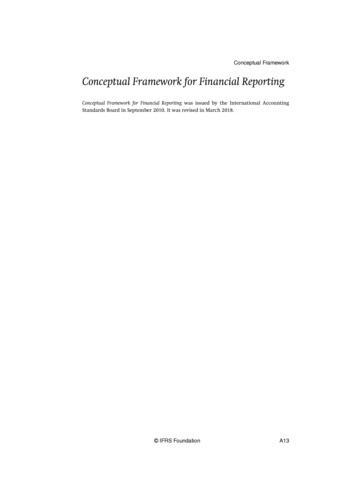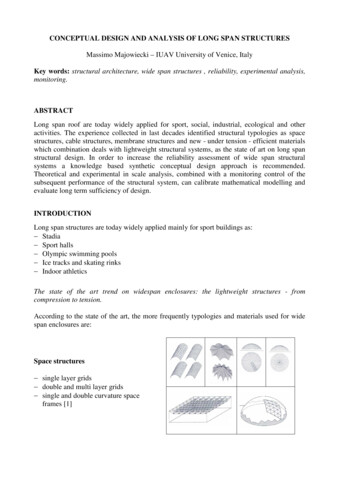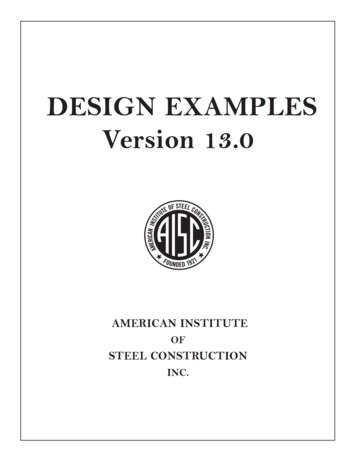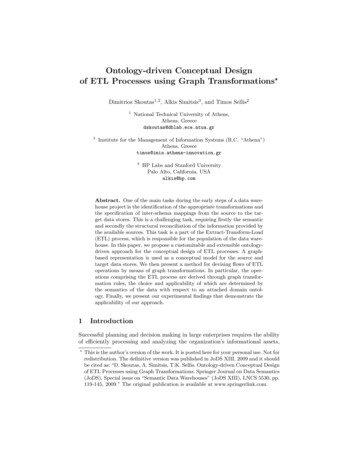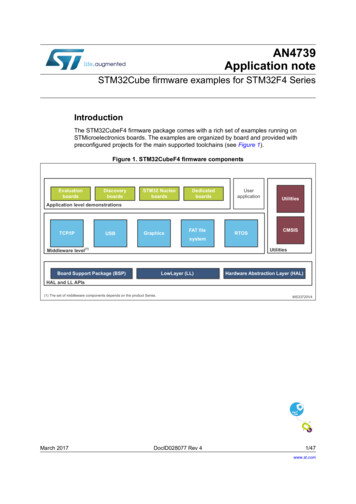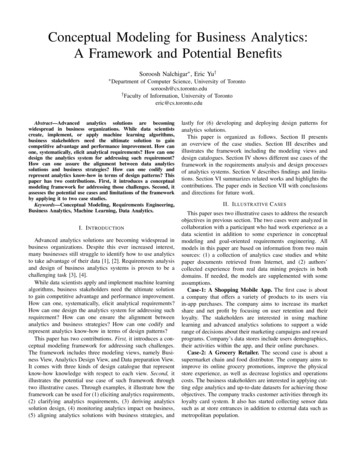
Transcription
EUROCODESBackground and ApplicationsBrussels, 18-20 February 2008 – Dissemination of information workshop1Conceptual design and designexamples for multi-storeybuildingsDr.-Ing. Christian MüllerDipl.-Ing. Matthias OppeRWTH Aachen
OverviewEUROCODESBackground and ApplicationsBrussels, 18-20 February 2008 – Dissemination of information workshop 2Client GuideCase StudiesScheme DevelopmentFlow ChartsNCCIExamplesOverviewClient GuideCase StudiesScheme DevelopmentFlow ChartsNCCIExamples
Client GuideEUROCODESBackground and ApplicationsBrussels, 18-20 February 2008 – Dissemination of information workshop3Client briefing: guides, case studies and conceptdesigns demonstrate the value that steel offersfor economic, fast, adaptable, safe, construction1. IntroductionCommercial buildings, such as offices, shops and mixed residential-commercial buildings,account for 20% of construction output in the EU, representing over 20 million square metres offloor space per year. The commercial sector demands buildings that are rapid to construct, of highquality, flexible and adaptable in application, and energy efficient in use.Steel and composite construction has achieved over 60% market share in this sector in somecountries of Europe where the benefits of long spans, speed of construction, improved qualityand reduced environmental impact have been recognised.A wide range of steel technologies may be used in commercial buildings. Specific technologies arechosen to match client requirements. Many long span steel solutions provide service integrationwithin their depth, which saves on building height. Cellular beams combine an efficient manufacturingprocess with opportunities for service integration. Integrated beams minimise the floor zone whileallowing services uninterrupted access below the floor soffit.OverviewClient GuideCase StudiesScheme DevelopmentFlow ChartsNCCIExamples
Client GuideEUROCODESBackground and ApplicationsBrussels, 18-20 February 2008 – Dissemination of information workshop42. Maximum Value from Steel Construction OverviewSpeed of ConstructionFlexibility and adaptabilityService integrationReduced disruption to the localityQualitySafer ConstructionEnvironmental BenefitsClient GuideCase StudiesScheme DevelopmentFlow ChartsNCCIExamples
Client GuideEUROCODESBackground and ApplicationsBrussels, 18-20 February 2008 – Dissemination of information workshop53. Construction Systems and their Ranges of ApplicationSpan rangeStructure depth800 mm6 to 15 m400 toComposite constructionusing steel deckingCellular beams in compositeconstructionSpan range 9 to 18 mStructure depthSpan range 9 to 20 mStructure depth600 to 1000 mm600 to 1200 mmFabricated or rolled beams with large web openingsOverviewClient GuideCase StudiesScheme DevelopmentFlow ChartsNCCIExamples
Client GuideEUROCODESBackground and ApplicationsBrussels, 18-20 February 2008 – Dissemination of information workshop6Integrated beams supportingprecast concrete slabsIntegrated beams with deep deckingSpan range 5 to 9 mStructure depthSpan range 5 to 9 mStructure depth300 to 350 mmSpan range 5 to 10 mStructure depth300 to 400 mm500 to 900 mmSteel beams supporting precast concrete slabsOverviewClient GuideCase StudiesScheme DevelopmentFlow ChartsNCCIExamples
Client GuideEUROCODESBackground and ApplicationsBrussels, 18-20 February 2008 – Dissemination of information workshop74. Specific Technologies for Commercial BuildingsCommercial buildings require a range of specific technologiesthat have been developed to meet client needs:Service Integration:Cellular beams with regular openings for servicesOverviewClient GuideCase StudiesScheme DevelopmentFlow ChartsNCCIExamples
Client GuideEUROCODESBackground and ApplicationsBrussels, 18-20 February 2008 – Dissemination of information workshop8Service integration inintegrated beamsFabricated beams with variety ofshapes of openingsOverviewClient GuideCase StudiesScheme DevelopmentFlow ChartsNCCIExamples
Client GuideEUROCODESBackground and ApplicationsBrussels, 18-20 February 2008 – Dissemination of information workshop9Fire ResistanceTubular columns exposed for fire resistanceOverviewClient GuideCase StudiesScheme DevelopmentFlow ChartsNCCIExamples
Client GuideEUROCODESBackground and ApplicationsBrussels, 18-20 February 2008 – Dissemination of information workshop10Energy EfficiencyEnergy efficient design atGLA building, LondonDouble façade in the Kone Building, FinlandOverviewClient GuideCase StudiesScheme DevelopmentFlow ChartsNCCIExamples
Client GuideEUROCODESBackground and ApplicationsBrussels, 18-20 February 2008 – Dissemination of information workshop11Cladding and infill walls large variety of cladding systems: traditional brickwork,curtain walling and glazing Light steel infill walls as sub-structure to all types of facades Double skin glazed façades to reduce solar gainLight steel infill walls used in steel framed buildingsOverviewClient GuideCase StudiesScheme DevelopmentFlow ChartsNCCIExamples
Case StudiesEUROCODESBackground and ApplicationsBrussels, 18-20 February 2008 – Dissemination of information workshop12Access Steel highlights the benefits ofsteel as the primary construction materialthrough detailed short case studies ofsuccessful buildings OverviewLe Sequana, ParisKista Science Tower, StockholmPlace d'lena, ParisOffice Building, Palestra, LondonLuxembourg Chamber of Commerce'sING Headquarters, AmsterdamSheraton Hotel, BilbaoClient GuideCase StudiesScheme DevelopmentFlow ChartsNCCIExamples
Le Sequana, ParisEUROCODESBackground and ApplicationsBrussels, 18-20 February 2008 – Dissemination of information workshop13near completationLe Sequana – artist’s impression 25,000 m² of exceptional quality office accommodation in the heart of the new commercial centre,Ville de Paris Column free spaces of 18 m x 36 m overlooking the Seine 33% pre-let from plan, prior to the commencement of construction Fully air conditioned with individual control for every 12m² Construction completed in 22 months to programme and budget, including the erection of 2000tonnes of structural steelwork in 12 weeksOverviewClient GuideCase StudiesScheme DevelopmentFlow ChartsNCCIExamples
EUROCODESBackground and ApplicationsKista Science Tower, StockholmBrussels, 18-20 February 2008 – Dissemination of information workshop14Kista Science Tower:42000 m2 of high quality office space in six buildings, 158 meters tall with 32 storeys.Long span steel trusses create open space overlooking northern Stockholm.OverviewClient GuideCase StudiesScheme DevelopmentFlow ChartsNCCIExamples
Place d Ilena, ParisEUROCODESBackground and ApplicationsBrussels, 18-20 February 2008 – Dissemination of information workshop15Completed building showing the new façadeDemolition stage of the originalconcrete frame Refurbishment of a building constructed in the 1960’s to create large open spaces for ahigh quality office building in one of the most prestigious districts in Paris The project involved preservation of the existing façades of the building, whichimposed a constraint on the method of building Creation of office open spaces of 1200 m² without intermediate columns Floor span of up to 14 m Service integration in cellular beams achieves minimum floor zone Construction completed in 22 monthsOverviewClient GuideCase StudiesScheme DevelopmentFlow ChartsNCCIExamples
EUROCODESBackground and ApplicationsOffice Building Palestra, LondonBrussels, 18-20 February 2008 – Dissemination of information workshop16 12 storey building of 31,5 to 36 m width and 90 mlength with a 9 m projection of the upper 4 floors Pairs of cellular beams were placed either side ofthe 4 inclined tubular columns. The cellular beamswere designed as continuous over a span of 15 min order to reduce their depth The floor-floor zone is a minimum of 3,65 m andthe structure and services zone is only 850 mm.The cellular beams permit passage of 400 mmdiameter circular service ducts Fully glazed façade, which was directly attached tothe composite slab The inclined tubular columns and shear connectionswere designed for an eccentric load transfer whichcarried bending in the columns. The columns usedinnovative double circular hollow sections filled withcement grout to achieve 120 minutes fireresistance Erection of the 3500 tonnes of steelwork in only 10monthsDuring construction, showing steelframework and fully glazed facadeOverviewClient GuideCase StudiesScheme DevelopmentFlow ChartsNCCIExamples
EUROCODESLuxembourg Chamber of Commerce sBackground and ApplicationsBrussels, 18-20 February 2008 – Dissemination of information workshop17Chamber of Commerce s 20 000 m2 of new 5 storey office space, a conference centre of 8 000 m² and 650 underground carparking spaces on 4 below ground levels. Full double-glazed ventilated façade with shading with serigraphed glass shields. Water-cooled composite slab using sinusoidal stainless steel façade, which acted as framework to theconcrete slab of 300 mm depth. No temporary propping was required. Integrated IFB beams with under-tied hollow sections to create a span of 12,5 m, which is 30% largerthan is possible with integrated beams. These beams are exposed usually. Fire engineering, using natural fire approach, led to a fully unprotected steel structure. These operating conditions for the water-cooled slab are:Summer-night-time; Summer-day-time and winter.Heating and cooling is provided Diaphragm action of composite slab and stability through the lift shaft.OverviewClient GuideCase StudiesScheme DevelopmentFlow ChartsNCCIExamples
ING Headquaters, AmsterdamEUROCODESBackground and ApplicationsBrussels, 18-20 February 2008 – Dissemination of information workshop18 9 storey steel structure of 20 000 m2 floor area supported on inclined columns. The 'nose' of the building provides an auditorium and cantilevers 26 m from the adjoiningstructure. A shallow construction depth of 310 mm was achieved using Slimdek for a structural grid ofapproximately 7 m. Slimdek consists of asymmetric steel beams (ASB) support a deepcomposite slab. The inclined columns support the entire weight of the building and provide overall stability.They are designed as composite sections.OverviewClient GuideCase StudiesScheme DevelopmentFlow ChartsNCCIExamples
ING Headquaters, AmsterdamEUROCODESBackground and ApplicationsBrussels, 18-20 February 2008 – Dissemination of information workshop19Composite floor slab in the auditorium area showing service penetrations The space between the inclined legs provides access to the building and to the below-ground carparking. A double skin glass façade was used to control 'solar gain' and regulate internal temperatures. Minimum ground works were required by concentrating loads at discrete points. A fire resistance of 90 minutes was satisfied by a fire engineering analysis. Slimdek minimised the visual impact of the structure, which was important for the architecturalconcept. Steelwork was supplied by a consortium of 3 fabricators. Erection of the 1 000 tonnes of steelworktook only 28 weeks.OverviewClient GuideCase StudiesScheme DevelopmentFlow ChartsNCCIExamples
Sheraton Hotel, BilbaoEUROCODESBackground and ApplicationsBrussels, 18-20 February 2008 – Dissemination of information workshop20 20 000 m² multi-storey luxury hotel in Bilbao: 11 above-ground storeys of 13 000 m² floor area: and4 below ground floors of 7 000 m² floor area. 211 rooms: one presidential suite, 20 suites and 190 double rooms. 1 100 tonnes of structural steelwork were used in the form of I and H sections, tubes and plates. Only 7 months for the erection of the steel structure. The Sheraton hotel has a high level of building services comprising: Full air conditioning system in all rooms and in common areas, and radiant flooring in the atrium. Architectural design for optimised energy requirements, such as natural cooling, solar gains or naturaldaylight. Emergency electric power plant for essential facilities, such as the fire protection, safety andUPS-supported computer network installations. Optical fibre voice and data networks to all rooms. Fire detection and extinguishing network, backed up by a computerizedmanagement system that enables the fire to be located immediately. Advanced Smoke Control systems and safe means of egress in fire.OverviewClient GuideCase StudiesScheme DevelopmentFlow ChartsNCCIExamples
Scheme DevelopmentEUROCODESBackground and ApplicationsBrussels, 18-20 February 2008 – Dissemination of information workshop2116 documentsConcise information on proposal development guides thearchitect and engineer through all the decisions thathave to be made to develop a best practice design OverviewForm and functionKey informationLocation and its influence on the design of MSBService strategies – OverviewService buildingsSustainability – OverviewSustainability factorsFire SafetyStructural SystemComposite Slabs, Web Openings etc.Vertical StructureClient GuideCase StudiesScheme DevelopmentFlow ChartsNCCIExamples
Scheme DevelopmentEUROCODESBackground and ApplicationsBrussels, 18-20 February 2008 – Dissemination of information workshop22Coordination of structural and architectural designfor multi-storey buildings with steel frames Floor Grids Influence of Building Height Horizontal Coordination Vertical Coordination: Floor-to-Floor Heights Vertical Coordination: Structural Zone Vertical Coordination: Service Zones Horizontal Structural Options Span Range of Structural Systems Benefits of Long Span Construction Approximate Steel QuantitiesOverviewClient GuideCase StudiesScheme DevelopmentFlow ChartsNCCIExamples
Scheme DevelopmentEUROCODESBackground and ApplicationsBrussels, 18-20 February 2008 – Dissemination of information workshop23Floor GridsInfluenced by: Planning Grid Column Spacing Use of internal space Requirements of BuildingService IntegrationColumn grid for long span floor ina prestige air-conditioned officeColumn grid for a naturally ventilated officeOverviewClient GuideCase StudiesScheme DevelopmentFlow ChartsNCCIExamples
Scheme DevelopmentEUROCODESBackground and ApplicationsBrussels, 18-20 February 2008 – Dissemination of information workshop24Building HeightThe building height has a strong influence on the: Structural system that is adopted.Foundation system.Fire resistance requirements and means of escape.Access (by lifts) and circulation space.Cladding system.Speed of construction and site productivity.The structural system is primarily influenced by the means of stabilizing thebuilding. For buildings up to 8 storeys high, vertical bracing is preferred,but for taller buildings, strategically placed concrete or braced steel coresare usually adopted. For ultra-tall buildings, many types of external bracingsystems have been used. These are outside the scope of this information.Sizes of lifts and their speed of movement also become important considerationsfor tall buildings. Depending on the Regulations for fire safety in the particularcountry, the use of sprinklers may be required or buildings of more than8 storeys.OverviewClient GuideCase StudiesScheme DevelopmentFlow ChartsNCCIExamples
Scheme DevelopmentEUROCODESBackground and ApplicationsBrussels, 18-20 February 2008 – Dissemination of information workshop25Horizontal coordination / Position of coresPositioning of cores isinfluenced by: Horizontal distribution systems formechanical services. Fire rating requirements, whichmay lead to shortened evacuationroutes, and to reducedcompartment sizes. The need to distribute thestructural stabilizing systemsmore-or-less symmetricallythroughout the building plan.Beam layout around a concrete coreOverviewClient GuideCase StudiesScheme DevelopmentFlow ChartsNCCIExamples
Scheme DevelopmentEUROCODESBackground and ApplicationsBrussels, 18-20 February 2008 – Dissemination of information workshop26Vertical coordination / Floor-to-Floor HeightsPrestige office3,8 – 4,2 mSpeculative office3,5 – 4,0 mRenovation project3,5 – 3,9 mVertical coordination / Structural ZoneComposite beamsSpan/depth ratio 25Cellular beamsSpan/depth ratio 25Fabricated primary beamsSpan/depth ratio 20Slim floor or integrated beamsSpan/depth ratio 25Vertical coordination / Service ZonesOverviewRaised access floor150 to 200 mmAir-conditioning units400 to 500 mmCeiling and lighting120 to 250 mmClient GuideCase StudiesScheme DevelopmentFlow ChartsNCCIExamples
Scheme DevelopmentEUROCODESBackground and ApplicationsBrussels, 18-20 February 2008 – Dissemination of information workshop27Horizontal Structural OptionsComposite beams (with composite slabs)Spans of 6 to 13 mNon-composite beams (with precast planks)Spans of 6 to 9 mPartially encased composite beamsSpans of 6 to 12 mCellular or fabricated beams (with composite slabs)Spans of 8 to 18 mSlim floor or integrated beamsSpans of 5 to 9 mForms of construction used in floors1.2.3.4.OverviewClient GuideCase StudiesComposite beamPartially encased beamIntegrated beamSlim floor beamScheme DevelopmentFlow ChartsNCCIExamples
Scheme DevelopmentEUROCODESBackground and ApplicationsBrussels, 18-20 February 2008 – Dissemination of information workshop28Horizontal Structural OptionsTypical long span secondary beamsOverviewClient GuideCase StudiesScheme DevelopmentFlow ChartsNCCIExamples
Scheme DevelopmentEUROCODESBackground and ApplicationsBrussels, 18-20 February 2008 – Dissemination of information workshop29Horizontal Structural OptionsTypical long span primary beams and shorter span secondary beamsOverviewClient GuideCase StudiesScheme DevelopmentFlow ChartsNCCIExamples
Scheme DevelopmentEUROCODESBackground and ApplicationsBrussels, 18-20 February 2008 – Dissemination of information workshop30Horizontal Structural OptionsIntegrated beams or slim floorOverviewClient GuideCase StudiesScheme DevelopmentFlow ChartsNCCIExamples
Scheme DevelopmentEUROCODESBackground and ApplicationsBrussels, 18-20 February 2008 – Dissemination of information workshop31Span Range of various structural systemsOverviewClient GuideCase StudiesScheme DevelopmentFlow ChartsNCCIExamples
Scheme DevelopmentEUROCODESBackground and ApplicationsBrussels, 18-20 February 2008 – Dissemination of information workshop32Benefits of Long Span ConstructionLong span beams have gained in popularity in the commercialbuilding sector because they offer the following benefits in designand construction: Internal columns are eliminated, leading to more flexible andefficient use of internal space. Services can be integrated within the depth of the structure,and so the floor-to-floor depth is not increased. Fewer components are required (typically 30% fewer beams)leading to reduced construction and installation time. Fire protection costs can be reduced due to the massivity of thelonger span members. For cellular beams, multiple circular ducts for services arecheaper than rectangular ducts. Steelwork costs are not increased significantly, despite thelonger spans. Overall building costs are increased by a negligible amount (lessthan 1%).OverviewClient GuideCase StudiesScheme DevelopmentFlow ChartsNCCIExamples
Scheme DevelopmentEUROCODESBackground and ApplicationsBrussels, 18-20 February 2008 – Dissemination of information workshop33Approximate Steel QuantitiesApproximate steel quantities (kg/m2 floor area)Form of BuildingBeamsColumnsBracingTotal3 or 4 storey building of rectangular form25–308–102–335–406–8 storey building of rectangular form25–3012–153–540–508–10 storey building with long spans35–4012–153–550–6020 storey building with a concrete core40–5010–131–255–6520 storey building with a braced steel core40–5020–258–1070–85OverviewClient GuideCase StudiesScheme DevelopmentFlow ChartsNCCIExamples
Flow ChartsEUROCODESBackground and ApplicationsBrussels, 18-20 February 2008 – Dissemination of information workshop3421 documentsEach design activity is described separatelyby a flow chart: OverviewEvaluation of wind loadsGoverning load combinationsFrame AnalysisChoosing a steel sub-gradeColumn designNon composite beams / Composite BeamsDesign of vertical bracingsSimple ConnectionsSecondary beam designClient GuideCase StudiesScheme DevelopmentFlow ChartsNCCIExamples
Flow ChartsEUROCODESBackground and ApplicationsBrussels, 18-20 February 2008 – Dissemination of information workshop3521 documentsEach design activity is described separatelyby a flow chart: OverviewEvaluation of wind loadsGoverning load combinationsFrame AnalysisChoosing a steel sub-gradeColumn designNon composite beams / Composite BeamsDesign of vertical bracingsSimple ConnectionsSecondary beam designClient GuideCase StudiesScheme DevelopmentFlow ChartsNCCIExamples
Flow ChartsEUROCODESBackground and Applications36Choosing a steel subgradeBrussels, 18-20 February 2008 – Dissemination of information workshopOverviewClient GuideCase StudiesScheme DevelopmentFlow ChartsNCCIExamples
Flow ChartsEUROCODESBackground and Applications37Choosing a steel subgradeBrussels, 18-20 February 2008 – Dissemination of information workshopOverviewClient GuideCase StudiesScheme DevelopmentFlow ChartsNCCIExamples
Flow ChartsEUROCODESBackground and Applications38Column designBrussels, 18-20 February 2008 – Dissemination of information workshopOverviewClient GuideCase StudiesScheme DevelopmentFlow ChartsNCCIExamples
Flow ChartsEUROCODESBackground and Applications39Column designBrussels, 18-20 February 2008 – Dissemination of information workshopOverviewClient GuideCase StudiesScheme DevelopmentFlow ChartsNCCIExamples
Flow ChartsEUROCODESBackground and Applications40Column designBrussels, 18-20 February 2008 – Dissemination of information workshopOverviewClient GuideCase StudiesScheme DevelopmentFlow ChartsNCCIExamples
Flow ChartsEUROCODESBackground and Applications41Column designBrussels, 18-20 February 2008 – Dissemination of information workshopOverviewClient GuideCase StudiesScheme DevelopmentFlow ChartsNCCIExamples
Flow ChartsEUROCODESBackground and Applications42Column design –Determination of interactioncriteria for both axesBrussels, 18-20 February 2008 – Dissemination of information workshopOverviewClient GuideCase StudiesScheme DevelopmentFlow ChartsNCCIExamples
Flow ChartsEUROCODESBackground and Applications43Column design –Determination of interactioncriteria for both axesBrussels, 18-20 February 2008 – Dissemination of information workshopOverviewClient GuideCase StudiesScheme DevelopmentFlow ChartsNCCIExamples
NCCIEUROCODESBackground and ApplicationsBrussels, 18-20 February 2008 – Dissemination of information workshop4434 documentsNon-contradictory, complementary information(NCCI) is presented that addresses all theinformation that the Eurocodes do not coverthat is essential for design, e.g.: OverviewCalculation of αcritVertical and horizontal deflection limitsEffective lengths of columnsTorsional Buckling (calculation of Ncr,T and Mcr,T)Design Rules for Web Openings in BeamsTorsion (Section Properties and stresses)VibrationsSizing GuidanceHorizontal and vertical BracingsDesign Model for simple Column SplicesChoice of Method for Frame AnalysisSimplified Bracing SystemsClient GuideCase StudiesScheme DevelopmentFlow ChartsNCCIExamples
NCCIEUROCODESBackground and ApplicationsBrussels, 18-20 February 2008 – Dissemination of information workshop4534 documentsNon-contradictory, complementary information(NCCI) is presented that addresses all theinformation that the Eurocodes do not coverthat is essential for design OverviewCalculation of αcritVertical and horizontal deflection limitsEffective lengths of columnsTorsional Buckling (calculation of Ncr,T and Mcr,T)Design Rules for Web Openings in BeamsTorsion (Section Properties and stresses)VibrationsSizing GuidanceHorizontal and vertical BracingsDesign Model for simple Column SplicesChoice of Method for Frame AnalysisSimplified Bracing SystemsClient GuideCase StudiesScheme DevelopmentFlow ChartsNCCIExamples
NCCIEUROCODESBackground and ApplicationsBrussels, 18-20 February 2008 – Dissemination of information workshop46Calculation of αcrThis NCCI sets out thebasis for the calculation ofαcr, the parameter thatmeasures the stability ofthe frame.OverviewClient GuideCase StudiesScheme DevelopmentFlow ChartsNCCIExamples
EUROCODESBackground and ApplicationsBrussels, 18-20 February 2008 – Dissemination of information workshop47Calculation of αcrOverviewClient GuideCase StudiesScheme DevelopmentFlow ChartsNCCIExamples
EUROCODESBackground and ApplicationsBrussels, 18-20 February 2008 – Dissemination of information workshop48Calculation of αcrOverviewClient GuideCase StudiesScheme DevelopmentFlow ChartsNCCIExamples
EUROCODESBackground and ApplicationsBrussels, 18-20 February 2008 – Dissemination of information workshop49Calculation of αcrOverviewClient GuideCase StudiesScheme DevelopmentFlow ChartsNCCIExamples
NCCIEUROCODESBackground and ApplicationsBrussels, 18-20 February 2008 – Dissemination of information workshop50Effective lengths of columnsThis NCCI gives information concerning the calculation of thebuckling length for columns, to be used for the bucklingverification (slenderness approach). Simple aids (e.g. tables,diagrams) are presented.OverviewClient GuideCase StudiesScheme DevelopmentFlow ChartsNCCIExamples
EUROCODESBackground and ApplicationsBrussels, 18-20 February 2008 – Dissemination of information workshop51Effectivelengths ofcolumnsOverviewClient GuideCase StudiesScheme DevelopmentFlow ChartsNCCIExamples
EUROCODESBackground and ApplicationsBrussels, 18-20 February 2008 – Dissemination of information workshop52Effectivelengths ofcolumnsOverviewClient GuideCase StudiesScheme DevelopmentFlow ChartsNCCIExamples
EUROCODESBackground and ApplicationsBrussels, 18-20 February 2008 – Dissemination of information workshop53Effectivelengths ofcolumnsOverviewClient GuideCase StudiesScheme DevelopmentFlow ChartsNCCIExamples
EUROCODESBackground and ApplicationsBrussels, 18-20 February 2008 – Dissemination of information workshop54EffectivelengthsofcolumnsOverviewClient GuideCase StudiesScheme DevelopmentFlow ChartsNCCIExamples
EUROCODESBackground and ApplicationsBrussels, 18-20 February 2008 – Dissemination of information workshop55Effectivelengths ofcolumnsOverviewClient GuideCase StudiesScheme DevelopmentFlow ChartsNCCIExamples
EUROCODESBackground and ApplicationsBrussels, 18-20 February 2008 – Dissemination of information workshop56Effective lengthsof columnsOverviewClient GuideCase StudiesScheme DevelopmentFlow ChartsNCCIExamples
ExamplesEUROCODESBackground and ApplicationsBrussels, 18-20 February 2008 – Dissemination of information workshop5713 documents Calculation of αcrit Choosing a steel sub-grade Simply supported secondary composite beams Simply supported primary composite beams Simply supported beam with lateral restraint at load Pinned column with intermediate restraint Sway stability Tying and avoidance of disproportionate collapse Beam to beam fin plate connection Beam to column end plate connection Column splice (Non-Bearing / Bearing) Column base, axially loadedOverviewClient GuideCase StudiesScheme DevelopmentFlow ChartsNCCIExamples
ExamplesEUROCODESBackground and ApplicationsBrussels, 18-20 February 2008 – Dissemination of information workshop5813 documents Calculation of αcrit Choosing a steel sub-grade Simply supported secondary composite beams Simply supported primary composite beams Simply supported beam with lateral restraint at load Pinned column with intermediate restraint Sway stability Tying and avoidance of disproportionate collapse Beam to beam fin plate connection Beam to column end plate connection Column splice (Non-Bearing / Bearing) Column base, axially loadedOverviewClient GuideCase StudiesScheme DevelopmentFlow ChartsNCCIExamples
EUROCODESBackground and ApplicationsChoosing a steel sub-gradeBrussels, 18-20 February 2008 – Dissemination of information workshopOverviewClient GuideCase Studies59Scheme DevelopmentFlow ChartsNCCIExamples
EUROCODESBackground and ApplicationsChoosing a steel sub-gradeBrussels, 18-20 February 2008 – Dissemination of information workshopOverviewClient GuideCase Studies60Scheme DevelopmentFlow ChartsNCCIExamples
EUROCODESBackground and ApplicationsChoosing a steel sub-gradeBrussels, 18-20 February 2008 – Dissemination of information workshopOverviewClient GuideCase Studies61Scheme DevelopmentFlow ChartsNCCIExamples
EUROCODESBackground and ApplicationsChoosing a steel sub-gradeBrussels, 18-20 February 2008 – Dissemination of information workshopOverviewClient GuideCase Studies62Scheme DevelopmentFlow ChartsNCCIExamples
EUROCODESBackground and ApplicationsChoosing a steel sub-gradeBrussels, 18-20 February 2008 – Dissemination of information workshopOverviewClient GuideCase Studies63Scheme DevelopmentFlow ChartsNCCIExamples
EUROCODESBackground and ApplicationsChoosing a steel sub-gradeBrussels, 18-20 February 2008 – Dissemination of information workshopOverviewClient GuideCase Studies64Scheme DevelopmentFlow ChartsNCCIExamples
Buckling resistanceEUROCODESBackground and ApplicationsBrussels, 18-20 February 2008 – Dissemination of information workshopOverviewClient GuideCase Studies65Scheme DevelopmentFlow ChartsNCCIExamples
Buckling resistanceEUROCODESBackground and ApplicationsBrussels, 18-20 February 2008 – Dissemination of information workshopOverviewClient GuideCase Studies66Scheme DevelopmentFlow ChartsNCCIExamples
Buckling resistanceEUROCODESBackground and ApplicationsBrussels, 18-20 February 2008 – Dissemination of information workshopOverviewClient GuideCase Studies67Scheme DevelopmentFlow ChartsNCCIExamples
Buckling resistanceEUROCODESBackg
1 100 tonnes of structural steelwork were used in the form of I and H sections, tubes and plates. Only 7 months for the erection of the steel structure. The Sheraton hotel has a high level of building services comprising: Full air conditioning system in all rooms

